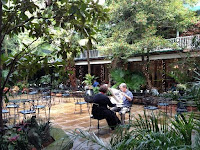 |
| FALAISE in Style of 13th Century Norman Manor House |
As a mansion museum built in the style of a 13th-century Norman Manor House its modest facade sets the stage for authenticity in its architectural design.
Falaise is a time capsule of treasures from an era that segued into the Art Deco period when the titans of great wealth and industry built summer mansions on the Gold Coast and F. Scott Fitzgerald was writing The Great Gatsby.
FALAISE, is an important tourist site as it is furnished with museum-quality antiques and artifacts, many of the 16th and 17th century. Falaise (French for "cliff") is aptly named as the back of the house is situated on a majestic bluff overlooking the Long Island Sound.
 |
| FALAISE The Majestic Cliff Terrace View |
The thickly mortared Dutch brick walls are an authentic testament to the style of Norman Manor Houses and overhead the thickly pitched roofs of heavy tile are original. Like a fairy tale image the round tower evokes the Medieval theme both outside and inside with archways, thick wood beams, textured plaster walls and a French carved stone fireplace mantel in the living room from a Chateau in France.
WHEN HARRY MARRIED CAROLINE
Falaise is a testament to a time well lived when polite society had the fortunes to indulge in their artistic pursuits and passion for antiquities. In 1923 when Harry F. Guggenheim married Caroline Morton, his father Daniel presented him with 90 acres of waterfront property on the Guggenheim estate, which at that time totaled 350 acres and included a gentleman's working farm. He could afford to be generous.
Construction of Falaise began in 1923 and was completed in 1924.
 |
| FALAISE: Grand Staircase from France |
The imposing grand staircase from France is another eye-catching feature that leads to private bedrooms modestly furnished; most have a view of the water. Don't miss the beautiful swimming pool located behind the house. Originally a rose garden it was replaced with a swimming pool because Harry was advised by his doctor to get more exercise
THERE'S SOMETHING ABOUT HARRY
Falaise may be main the attraction but there is something about Harry that is worth the telling. For one thing, he was not a playboy. Harry Guggenheim had a strong commitment to public service, was a businessman, diplomat, publisher, philanthropist, aviator and horseman.
Amazing as the time frame may seem, a Navy pilot, Captain Harry F. Guggenheim served in both World War I and World War II and you can still see his uniform and other diplomatic clothing as he was Ambassador to Cuba during the Hoover Administration. Harry was an ideal ambassador and tapped into his fluency in Spanish, which he mastered working in the Guggenheim family's mining business, and that. dear readers, is where the clan garnered a great fortune,
 |
| FALAISE: Living Room with French Carved Mantle |
Harry had a great interest in aviation and was a close friend of Charles Lindbergh, who was a frequent visitor to Falaise, particularly after the tragic death of his son, he wrote the book "We" there.
Harry continued to support aviation progress and was instrumental in securing funding for the research of rocket pioneer Robert Goddard. and helped organize the Daniel and Florence Guggenheim Jet Propulsion Center at the California Institute of Technology and the Guggenheim Laboratories for Aerospace Propulsion Sciences at Princeton University.
You may be familiar with Newsday, but you might not know that the newspaper was founded by Harry and his third wife, Alicia Patterson in 1940. During her tenure as editor and Harry as publisher the circulation reached 450,000 and received the Pulitzer Prize in 1954.
Horse Racing also caught Harry's entreprenurial enthusiasm. He raised and raced thoroughbred horses and helped to establish the New York Racing Association. Don't forget to go downstairs at Falaise where his trophies, awards and racing memorabilia are on display. Just so you know, Harry's 1953 Kentucky Derby winner Dark Star, was the only horse to defeat the legendary Native Dancer.
Touring Falaise is the perfect way to experience the Gold Coast lifestyle in this meticulously and lovingly preserved historic home that reflects Harry's lifestyle and visionary achievements. Open for docent-led tours from May 19 through November 20, 2016. Tickets $10 can be purchased at the Gate House, 127 Middle Neck Road, Sands Point. Best to call to check availability for tours at l, 2 and 3 pm. 516.571.7901.
Ta Ta, Dear Readers: Comments welcome at pollytalknyc@gmail.com. Please visit Polly's other Blogs at www.pollytalk.com.





















